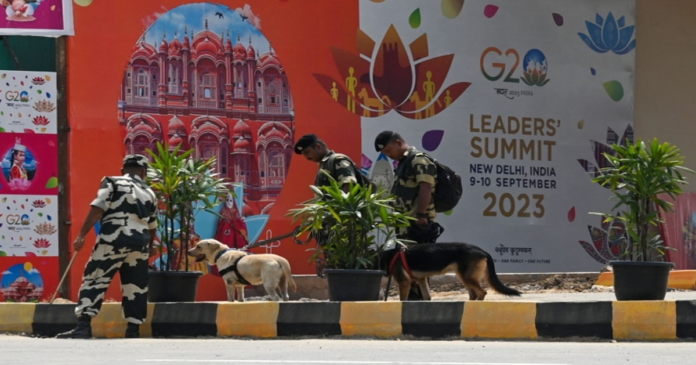India’s extensive G20 preparations include special personnel, armoured vehicles, and guys hired to shoo away monkeys as Prime Minister Narendra Modi gets ready for a weekend in the spotlight.
New Delhi readies for global summit: images of a happy India is hosting the most significant summit it has ever hosted, and Modi are lining the streets of the nation’s capital, New Delhi, to welcome foreign leaders.
In advance of the general elections in India next year, Modi has utilised the G20 presidency to strengthen his reputation as a steward of national power and prosperity both at home and abroad.
India overcame erstwhile colonial power Britain last year to claim the fifth-largest economy in the world, and it eclipsed China this year to claim the title of most populated nation.
Here is how the red carpet has been laid out by the officials.
‘Black Cats’ and roof-top snipers
Tens of thousands of security officers are actively participating in security operations, which involve utilizing anti-drone technology and deploying rooftop snipers.
In order to practise quick deployments from helicopters and rappelling down ropes onto hotel roofs where presidents will be sleeping, India’s anti-terrorism “Black Cats” guards have been exercising.
Bullet-proof limos will transport visiting leaders, while the traffic police have promised “elaborate regulations” with a massive restricted zone slapped across much of the city centre.
The government has instructed businesses to close, and they have announced a holiday, ensuring that the normally congested streets and their ubiquitous motorized rickshaws will be quiet.
The summit takes place at the recently renovated conference facility known as Bharat Mandapam.
The expansive riverbank location is adjacent to Raj Ghat, the Mahatma Gandhi memorial at the site of his cremation, where G20 leaders are expected to plant trees. It is also near the towers of the Purana Qila fort, built during the Mughal Empire in the 16th century.
cleaning campaign
Since India inherited the G20 presidency last year, the Delhi metropolitan area, which is home to some 30 million people, has been the focus of an extensive beautification campaign.
The megacity’s reputation for chaotic roadways and pollution is something that city officials are working hard to change.
Municipal officials claim that they have relocated more than 4,000 homeless persons who were previously sleeping under bridges and along roadsides in the city’s downtown into “shelter homes” in advance of the summit.
A number of long-shuttered fountains are now operational, and roadside markings that had long since faded now sparkle with new paint.
All across the city, there are over 70,000 flower pots.
The Times of India reports that authorities have dispatched 35 water tankers to keep the plants green, and the maintenance and monitoring of the foliage have become a significant effort in and of itself.
Numerous statues have appeared across the city centre, including an 8.5-meter-tall statue of the Hindu deity Shiva that stands 28 feet tall at the entrance to the G20 summit location.
Insect fish and monkey guys
To prevent marauding monkeys from chomping on flower arrangements set out for world leaders, authorities have dispatched a crew of more than 30 “monkey-men” and set up primate cutouts.
In the city, monkeys are a serious threat, frequently destroying rooftops, offices, and gardens, and occasionally aggressively assaulting people in search of food.
The men imitate the aggressive langur monkey’s shouts and hoots, which are the smaller rhesus macaque primates’ natural adversaries and cause havoc in the capital’s green administrative districts.
However, officials abandoned plans to pick up and conceal thousands of stray dogs after citizens of Delhi and animal rights activists expressed their outrage at the dog-catching plan.
According to the Hindustan Times, authorities have deployed eight crews with insecticide sprayers to sprinkle possible mosquito breeding places throughout the G20 location due to the mosquito-borne dengue and malaria problems in New Delhi.
An official informed the publication that they had thrown batches of mosquitofish, which consume larvae, into about 180 lakes and fountain pools before the conference.

